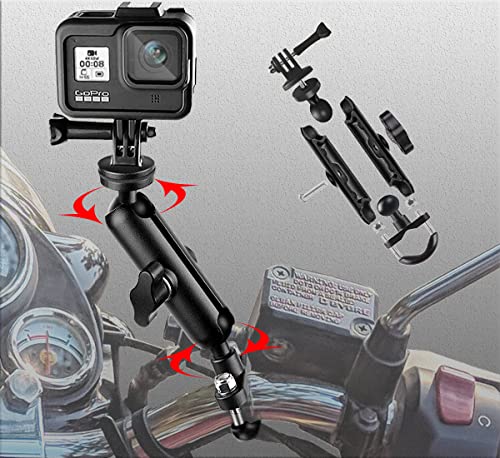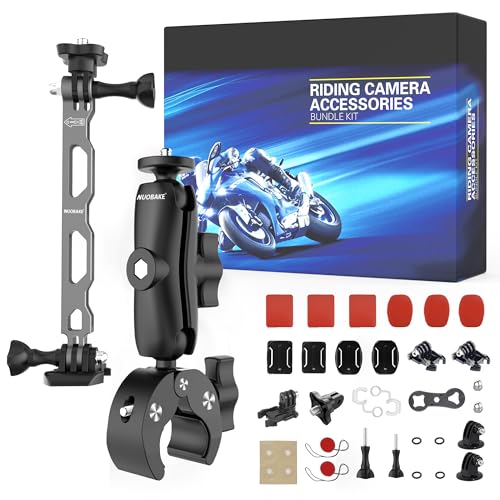Where to Mount Camera on Motorcycle: A Comprehensive Guide
Revise your engines and get ready for an exhilarating ride into the world of motorcycle videography! Whether you’re a thrill-seeking rider or a passionate filmmaker, capturing your two-wheeled adventures on camera is an absolute must.
But where do you mount that trusty lens to ensure epic footage without compromising safety or style? Fear not, for we have the answers you seek.
In this guide, we dive deep into camera mounting options for motorcycles. From the futuristic BikeEye rearview camera to the ever-popular Insta360 X3, Insta360 Go 3, and GoPro Hero 11 Black, we explore the top choices that will turn your journeys into cinematic masterpieces.
So, grab your helmet and join us as we unravel the mystery of the perfect camera placement for your motorcycle!
Where to Mount the Camera on a Motorcycle?
The question of where to mount a camera on a motorcycle depends on the purpose of the filming. For on-bike video footage, bullet-style cameras are recommended.
Different scenarios such as track day footage, touring holidays, and daily commutes require different mounting positions. One option is the BikeEye rearview camera, which provides a safer riding experience and a better field of view.
Mounting styles include fixed, suction, and clamp mounts, while alternatives such as gaffer tape or self-adhesive Velcro can also be used. Powering the camera can be done through the bike’s battery or using a rechargeable lithium battery.
When it comes to recording video footage, options like camcorders or solid state DVRs can be used. Multi-camera configurations are possible, with options like the Quattro camera processing unit allowing for independent camera selection or a picture-in-picture configuration.
Top choices for motorcycle cameras include the Insta360 X3, Insta360 Go 3, and GoPro Hero 11 Black. Other camera options mentioned are the INNOVV H5, Sena 50C, and Innovv K3.
Mounting options can vary, such as placing the camera on the tank or handlebars. It is important to note that camera models and rankings can change over time, so staying updated on the latest options is recommended.
Additional resources, like the Insta360 One X2 review, can provide further information.
Key Points:
- Mounting a camera on a motorcycle depends on the purpose of filming.
- BikeEye rearview camera is recommended for on-bike video footage.
- Different scenarios require different mounting positions.
- Mounting styles include fixed, suction, clamp mounts, and alternatives like gaffer tape or self-adhesive Velcro.
- Powering the camera can be done through the bike’s battery or a rechargeable lithium battery.
- Top choices for motorcycle cameras are the Insta360 X3, Insta360 Go 3, and GoPro Hero 11 Black.
Check this out:
💡 Pro Tips:
1. Consider mounting the camera on the front forks for a unique perspective that captures the motorcycle’s movement and the road ahead.
2. If you’re looking for a more immersive experience, try mounting the camera on your helmet using a specialized helmet mount.
3. Experiment with different angles and positions when mounting the camera to find the one that gives you the best view without obstructing your vision or interfering with your riding experience.
4. When mounting the camera, make sure it is secure and stable to prevent vibrations and ensure high-quality footage.
5. Don’t forget to clean the camera lens regularly to avoid blurry or distorted footage caused by dirt or dust on the lens.
Bullet-Style Cameras For Filming On-Bike Video On Motorcycles
When it comes to capturing on-bike video on motorcycles, bullet-style cameras are the preferred choice. These cameras are specifically designed to withstand the vibrations and environmental conditions that come with riding on a motorcycle.
Their sleek design allows them to be easily mounted, providing a seamless and aerodynamic look.
Bullet-style cameras are known for their versatility and ability to capture high-quality footage. With their wide-angle lenses, they can capture a larger field of view, ensuring that every moment is captured on camera.
Whether you’re riding on the track, going on a touring holiday, or simply commuting to work, a bullet-style camera is your best bet for capturing stunning footage.
Different Scenarios For Filming On A Motorcycle
There are various scenarios where filming on a motorcycle can add value and enhance the riding experience. One popular scenario is capturing track day footage.
Many riders love to document their exhilarating moments on the track, from high-speed straights to heart-pumping cornering. With a properly mounted camera, you can relive these moments and improve your riding skills by analyzing your techniques.
Another scenario is filming during touring holidays. Exploring new places on your motorcycle is a thrilling adventure, and documenting it allows you to share your experiences with others.
From scenic landscapes to memorable encounters, capturing it all with your camera creates lasting memories.
Daily commutes can also be a great opportunity to film on your motorcycle. Documenting your daily rides can serve as a safety precaution, as it allows you to review any incidents or near-misses that may occur.
Additionally, it provides a unique perspective on your daily routine, adding an extra level of excitement to your otherwise ordinary journeys.
Advantages Of The Bikeeye Rearview Camera
The BikeEye rearview camera is a game-changer in the world of motorcycle cameras. It offers a safer and better field of view compared to traditional rearview mirrors.
With its wide-angle lens, it eliminates blind spots and provides riders with a clear view of their surroundings.
One of the advantages of the BikeEye rearview camera is its ability to record footage continuously while you ride. This feature is invaluable when it comes to capturing any unexpected incidents on the road.
In case of an accident or dispute, having recorded evidence can prove crucial in determining fault and protecting your interests.
Additionally, the BikeEye camera is designed to be weatherproof and durable, ensuring that it can withstand the harsh conditions of riding. Its compact size and easy installation make it a convenient choice for motorcycle enthusiasts.
Suggested Camera Options And Mounting Positions
When it comes to choosing a camera for your motorcycle, there are several options to consider. The Insta360 X3 is highly recommended for its exceptional image stabilization and 360-degree field of view.
Its compact size and ease of use make it a popular choice among motorcycle riders.
The Insta360 Go 3 and GoPro Hero 11 Black are also worth considering. The Insta360 Go 3 is known for its versatility and magnetic mounting system, allowing for easy attachment to various parts of the motorcycle.
The GoPro Hero 11 Black offers incredible video quality and advanced features, making it a top contender for motorcycle filming.
Other camera options include the INNOVV H5, Sena 50C, and Innovv K3. These cameras offer a range of features, such as GPS tracking, audio recording, and live streaming capabilities.
It’s important to research each option thoroughly to determine which camera best suits your specific needs and preferences.
When it comes to mounting positions, there are various options to consider. Some popular choices include mounting the camera on the tank, handlebars, or helmet.
Each position offers a different perspective and field of view, so it’s essential to test out different positions to find the one that works best for you.
Various Mounting Styles And Attachment Methods
Mounting the camera on your motorcycle can be done using different styles and attachment methods. Fixed mounts are a common choice for secure and permanent mounting.
These mounts are typically attached to a specific part of the motorcycle, ensuring that the camera remains stable even during high speeds or rough terrain.
Suction mounts are another option, offering easy installation and adjustability. These mounts use suction cups to attach the camera to a smooth surface, such as the tank or windshield.
They provide flexibility in positioning and allow for quick adjustments on the go.
Clamp mounts are ideal for attaching the camera to handlebars or other tubular parts of the motorcycle. These mounts offer a secure grip and are often adjustable to achieve the desired angle and position.
In addition to traditional mounting styles, there are alternative methods of attaching the camera. Gaffer tape or self-adhesive Velcro can be used to securely attach the camera to various parts of the motorcycle.
While not as permanent or adjustable as dedicated mounts, these attachment methods can provide a quick and effective solution when a mount is not readily available.
Powering The Camera And Options For Recording Video Footage
Powering your camera can be done through various methods. Some cameras can be directly connected to the motorcycle’s battery, ensuring a continuous power supply.
This option is convenient for long rides or when you want to capture footage for an extended period of time.
Alternatively, rechargeable lithium batteries provide a portable and reliable power source. These batteries typically last for hours and can be easily charged using a USB cable.
They offer flexibility and convenience, allowing you to capture footage even when your motorcycle is not running.
When it comes to recording the video footage, there are different options to consider. A dedicated camcorder provides high-quality video footage and often offers more advanced features and settings.
These camcorders are specifically designed for capturing action-packed moments and can provide excellent image stabilization and audio recording capabilities.
Another option is a solid state DVR, which can record footage from multiple cameras simultaneously. This allows for a multi-camera configuration, such as having one camera mounted on the front and another on the rear of the motorcycle.
Some DVRs even offer a quattro camera processing unit, allowing for independent camera selection or a picture-in-picture configuration.
Conclusion
Mounting a camera on your motorcycle opens up a world of possibilities for capturing thrilling, scenic, and memorable moments. Bullet-style cameras are the go-to choice for recording on-bike video due to their durability and superb performance.
Whether you’re on the track, embarking on a tour, or simply commuting, there’s a camera and mounting position that’s perfect for you.
Consider the advantages of the BikeEye rearview camera for enhanced safety and better field of view. Explore different camera options such as the Insta360 X3, Insta360 Go 3, and GoPro Hero 11 Black, each offering unique features and capabilities.
Experiment with various mounting styles and attachment methods, ensuring a secure and adjustable setup.
Power your camera using either the motorcycle’s battery or a rechargeable lithium battery, depending on your needs. Explore options for recording video footage, whether using a camcorder for high-quality recordings or a solid state DVR for multi-camera configurations.
Remember, always prioritize safety when mounting and using a camera on your motorcycle. Follow manufacturer guidelines and local laws to ensure a secure and legal setup.
With the right camera and mounting position, you’ll be able to capture and relive your motorcycle adventures for years to come.
Sources
https://www.4kam.com/motorcycle_camera_bike_cam_setup.htm
https://www.motorcycle.com/products/the-5-best-motorcycle-cameras
https://bikepics.com/blog/ultimate-guide-to-mounting-any-camera-on-your-motorcycle/
https://www.youtube.com/watch?v=RyzRuOcXmF8









